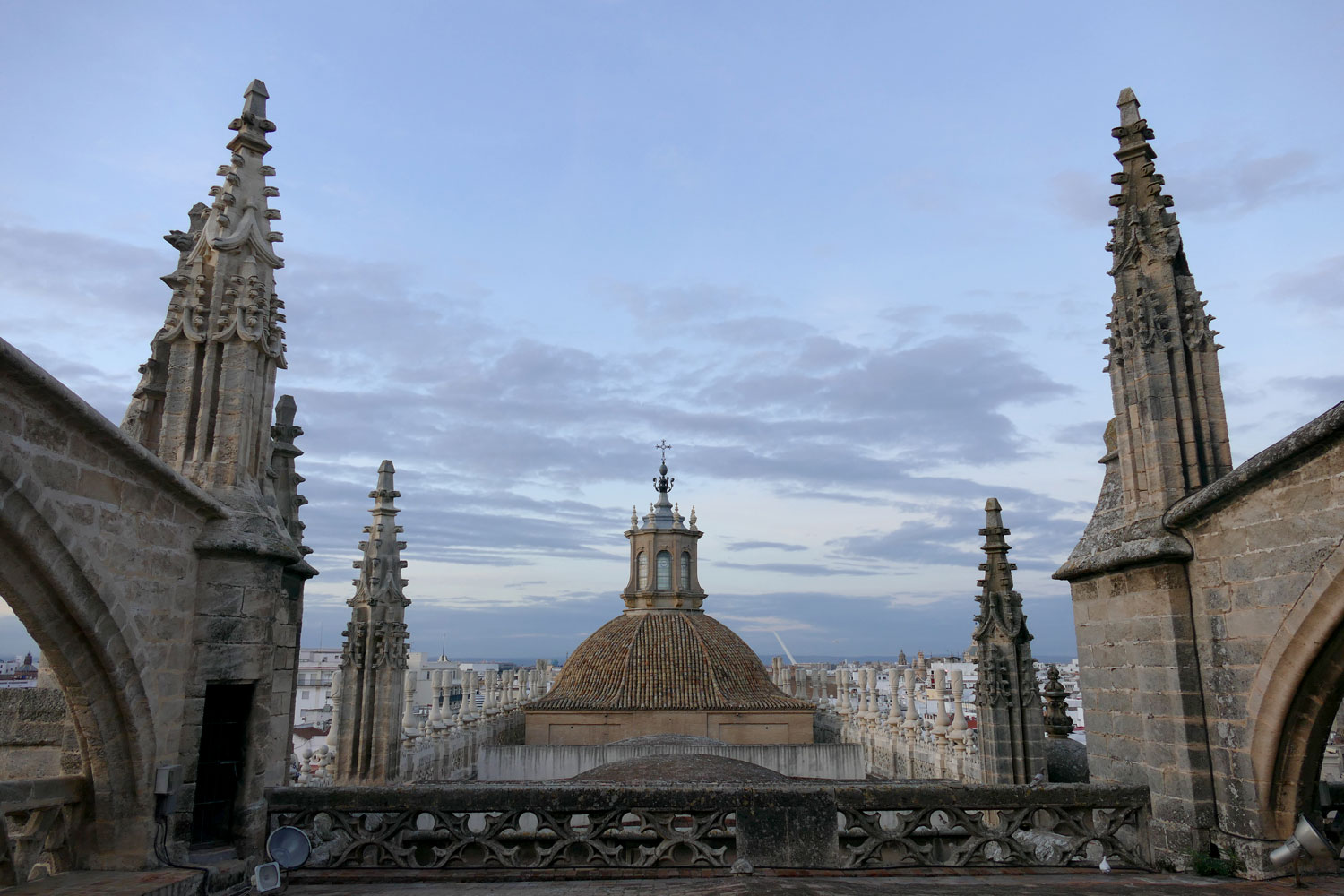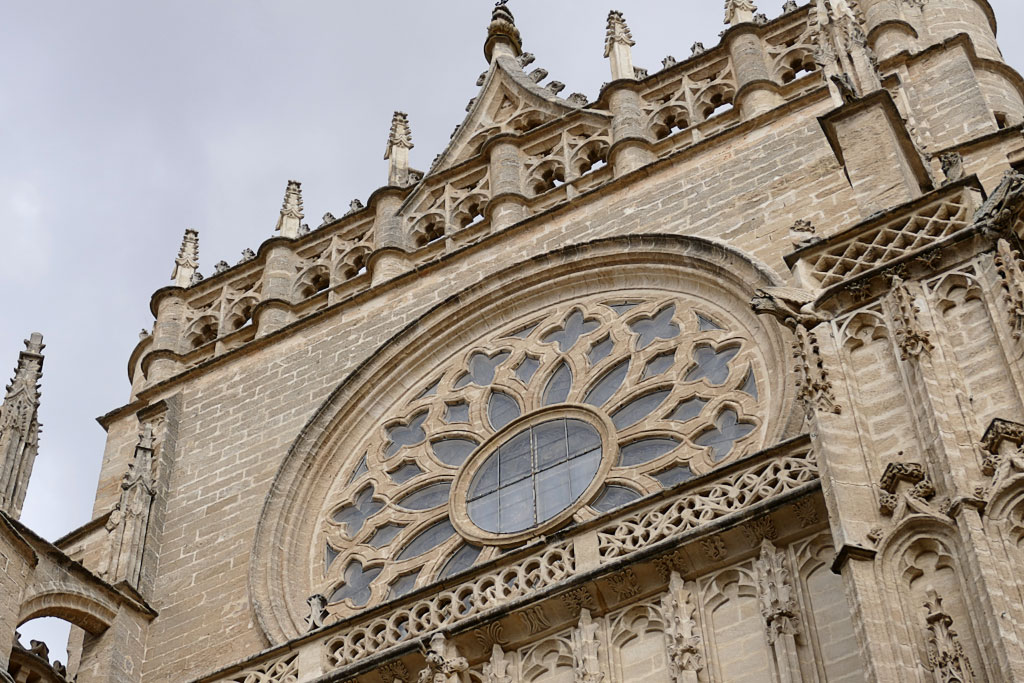Se dice que, cuando en el siglo XV se decidió levantar un nuevo templo, uno de los canónigos sentenció: «Hagamos una iglesia tan grande que los que la vieren acabada nos tengan por locos». Y, sin duda, no es una exageración pues la Catedral Hispalense es el mayor templo gótico del mundo y el tercero de la Cristiandad, después de San Pedro del Vaticano y San Pedro de Londres.
Compuesta por cinco naves, está repleta de exquisitos tesoros artísticos. La Capilla Mayor ocupa un tramo de la nave central, destacando las rejas de hierro y los púlpitos, que datan del siglo XVI. Por su parte, el Retablo Mayor se realizó en distintas fases durante cerca de un siglo, entre los años 1482 y 1564, según las trazas de Pyeter Dancart. Si bien, también intervinieron Pedro Millán, los hermanos Jorge Fernández Alemán y Alejo Fernández, Roque Balduque, Juan Bautista Vázquez el Viejo y Pedro de Heredia.
Igualmente destacable es el gran Coro, que ocupa otro tramo de la nave central y cuya sillería se realizó entre los siglos XV y XVI. Siguiendo este recorrido por el interior de la ‘Magna Hispalensis’ llegamos a la Capilla Real.
Situada en el muro de la cabecera y realizada por Martín de Gaínza, en el siglo XVI, sustituyó al antiguo ábside gótico. La Virgen de los Reyes, imagen gótica de la segunda mitad del siglo XIII y que perteneció al propio rey San Fernando, es venerada en la hornacina principal del Retablo. Ante su Altar se puede contemplar una urna de plata dorada y cristal, que contiene el cuerpo incorrupto del rey de Castilla.
También el arte plateresco encuentra un lugar destacado entre los muros de la Catedral de Sevilla. Buena muestra de ello es la Sacristía Mayor, que comenzó a construir Diego de Riaño y la continuó y finalizó Martín de Gaínza, a mediados del siglo XVI.
La capital hispalense, a través de su Catedral, le rinde homenaje también a la figura de Cristóbal Colón. Los restos del navegante genovés descansan en su interior, traídos de la Catedral de la Habana al independizarse de Cuba, como bien puede leerse en los laterales del sepulcro. El conjunto escultórico está compuesto por cuatro heraldos que llevan el féretro a hombros y representan cada uno de los reinos de la Corona Española: Castilla, León, Aragón y Navarra.
Acompañando y enriqueciendo este paseo artístico por la Catedral se alza el excepcional conjunto de vidrieras, la mayoría de las cuales se realizaron en el siglo XVI.
Horario: lunes, de 11.00 a 15.30 horas. Martes a sábado, de 11.00 a 17.00 horas. Domingo, de 14.30 a 18.00 horas. Festivos consultar.
Precios: Adultos: 8 € (incluida visita a la Iglesia del Salvador). Estudiantes menores de 26 años y pensionistas, 4 €.


The Cathedral of Seville occupies the site of a great mosque built in the late 12th Century and still maintains the bell tower, known as the Giralda, which is a legacy of this Moorish structure. Work on the Christian cathedral began under the reign of King Fernando the III of Castile, conqueror of Seville in the 13th Century, who hardly modified the original architecture.
In the 15th Century when the decision was made to build a new temple, the intention was “to make a church that is so huge that those who see it will think we are mad”. This was not an exaggeration as the Seville Cathedral is the largest gothic temple in the world and the third largest Christian cathedral following Saint Peter’s in the Vatican and Saint Paul’s in London.
The Cathedral is made up of five naves each filled with exquisite artistic treasures. The main chapel, with its monumental 15th Century forged iron grilles designed by Brother Francisco of Salamanca, takes up the central part of the building. The Main Altarpiece is considered to be one of the greatest in the Christian world. The relief panels designed by Peter Dancart were carved by Spanish and Flemish sculptors between 1482 and 1564. The Spanish sculptors included Pedro Millán, the brothers Jorge Fernández Alemán and Alejo Fernández, Roque Balduque, Juan Bautista Vázquez el Viejo and Pedro de Heredia.
The choir, with seats that were designed in the 15th and 16th Century and which is found in a nave off the Main Chapel, is also remarkable. Continuing along this impressive hall we come to the brilliant interior of the ‘Magna Hispalensis’, the Royal Chapel.
Inside the Royal Chapel there is a 16th Century mural by Martín de Gainza which replaced the gothic apse. There is also a gothic effigy of the Virgen de los Reyes (Virgin of the Kings) dating from the second half of the 13th Century which belonged to King Fernando himself and which is the centrepiece of the altar. The gold plated glass urn found in front of the altar contains the remains of this Castilian king.
Examples of Plateresque art work can also be found within the walls of the Cathedral of Seville. One example of this style can be seen in the Main Sacristy, which was begun by Diego de Riaño and continued and completed by Martin de Gainza in the mid 16th century.
Seville, through its Cathedral, also pays homage to Christopher Columbus. The remains of this Italian navigator are kept here where they were brought from the Cathedral of Havana when Cuba became independent (as stated in the texts next to the mausoleum). The sculpture found here is made up of four heralds which represent the four Spanish kingdoms (Castilla, Leon, Aragon and Navarra) carrying the casket.
Adding to the richness of this artistic visit to the Cathedral are the exceptional stained glass windows, the majority of which were made in the 16th century.
